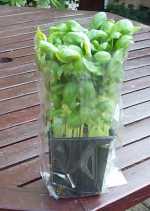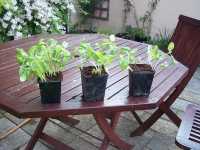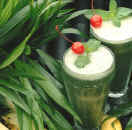|
|
|
|||||
|
|
||||||
|
||||||||||
|
Fast Growing Trees Fastest
Deciduous |
|
Faster
Deciduous |
|
Fast
Deciduous
Evergreen |
|
Fast Growing
Hedging Plants
Deciduous
Evergreen
Arborvitae
Douglas Fir |
Make the Most of Supermarket Herbs |
More about Fruit Trees: Apple and Crab-apples | Apricot | Cherry | Peaches and Nectarines | Pear | Plums and prunes | Pests and problems | Hints and tips |
The cheapest herb plants available these days are often from your local supermarket. They're sold in pots of what are basically overgrown, over crowded plants that should have been pricked out long ago. This doesn't matter of course if you're going to pick all of the leaves and throw the rest away.
With a little bit of effort however it is possible to make a pot of herbs last for months on end and keep a fresh supply on the kitchen windowsill all summer for the price of one pot.
 Here's
one of my favourite herbs, basil, as bought from the supermarket
in its cellophane wrapper. This 7cm square pot cost me 99 cents. Here's
one of my favourite herbs, basil, as bought from the supermarket
in its cellophane wrapper. This 7cm square pot cost me 99 cents.
Take the herbs out and remove the pot. You will have around 20-30 individual plants each of which are very leggy and not what you would use normally. Take another 2 pots however of the same size and some potting compost. First of all split the roots and compost in two equal halves by pulling apart gently. Take one of these halves and split it again. Take one of these quarters and split it carefully so as not to damage the delicate stems that are probably intertwined by now, into three of four clumps of a few (3-4) plants each. |
 Take
each of these mini clumps and place one into each of the corners of
a new plant pot. Fill in the gaps with potting compost. Take
each of these mini clumps and place one into each of the corners of
a new plant pot. Fill in the gaps with potting compost.
You will have two pots that are sparsely filled and should have one large clump left of half the original pot size. Split this into two halves and place the two halves into the original pot in opposite corners filling in the gaps with potting compost - harlequin style with opposing corners either with plants or compost.
|
 The
end result is three pots of herbs of different densities from the original
one. Water them well and place onto a sunny windowsill. The
end result is three pots of herbs of different densities from the original
one. Water them well and place onto a sunny windowsill.
Leave for a week or so before you begin to pick them and pick first from the densest pot. When this has been decimated, leave it some time to recover and move onto the next densest which should have put a fair amount of growth on by now, then eventually move onto the last. Remember to water well and feed as you would house plants. If you put the plants on the sunniest windowsill possible, then you will have a good supply for months on end. Herbs always do best in full sun, and varieties like basil in particular need full direct sun to develop their best flavor. |
|
When gathering herbs, treat it like pruning the plant. You'd never prune by removing leaves and leaving a naked stem so apply the same principle to your herbs and you'll be rewarded with more and more leaves to pick and better looking plants. Depending on the variety, try to pick whole or part stems that you then strip of leaves. Cut the stem at a point where there are emerging side-shoots. Basil has side shoots at leaf junctions and so tolerates leaf stripping to some degree, whereas mint doesn't and responds better to having whole stems cut at about ground level. |
|
|
Supermarket pots are fine, but its not the same as popping out to the garden to cut herbs from a long lasting bush that you've nurtured.
Many herbs can be grown easily and quickly in a small space. But don't forget about the many useful perennial herbs that take no trouble to grow, look wonderful and add a huge amount to the potential of the kitchen.
Even the largest perennial herbs can be grown in a small garden because they tend to do their growing up rather than out and the nature of a herbaceous perennial is that it can be dug up each winter, chopped up, reduced, divided or merely replanted without showing the slightest sign of distress the following April when it starts to grow again.
Don't bother with those titchy
little "herb wheels" that have four or more compartments to grow the herbs
in, they produce about enough for the occasional meal for one. If you want to
grow them in a "herb container" make it big, at least 3 feet square, raised
above the patio so that you can sit on the edge and smell the herbs as you brush
against them![]()
 Mint
is something of an exception as it "grows like a bugger" as my granddad
so eloquently put it. It has a habit of spreading into every nook and cranny once
it gets going. The customary advice is to plant it in a bottomless bucket sunk into
the ground.
Mint
is something of an exception as it "grows like a bugger" as my granddad
so eloquently put it. It has a habit of spreading into every nook and cranny once
it gets going. The customary advice is to plant it in a bottomless bucket sunk into
the ground.
I've never tried this but quite honestly can't see it working too well. Mint spreads admirably over surfaces, a wind battered stem will root where it touches the ground and shallow roots will soon creep over the bucket rim. I also have faith in the ability of mint to grow down under the bottom rim of the bucket and escape that way.
Better to grow it in a (large) container or curb its enthusiasm by planting it in a difficult spot in the garden. Where other plants may die or sulk miserably, mint will be somewhat chastised but soldier on regardless.
There are many types of mint to try,
applemint ( Mentha suaveolens ) and spearmint ( Mentha spicata ) are
the most useful for everyday purposes. Have peppermint ( Mentha x piperita
), if you want to make peppermint tea. There are lots of other types if you have
the space such as pineapple mint, lemon mint, basil mint, eau de cologne mint, curly
mint and mountain mint.
![]()
![]() Fennel ( Foeniculum vulgare )
Fennel ( Foeniculum vulgare )
is a Mediterranean herb that naturally
seeds itself in very dry, sunny spots in poor soil, popping up in gravel paths,
between bricks and cobbles and even on walls. The leaves can be laid over
a fish before grilling or baking, but the plants real herby brilliance is from its
seeds. These are produced in great abundance in late summer after the mass of flowers
are over. Florence fennel used as a vegetable is a different thing altogether
(though bred from the herb).![]()
 is another really easy to grow herb. Put it in a sunny spot and it almost can't
help itself to grow - which is always an admirable quality in a plant that you intend
to cut bits off on a regular basis.
is another really easy to grow herb. Put it in a sunny spot and it almost can't
help itself to grow - which is always an admirable quality in a plant that you intend
to cut bits off on a regular basis.
I love oregano leaves in a mixed green salad along with a generous helping of basil. I'm not a great fan of frilly, bitter, funny colored lettuces in a green salad, but these two leaves with spinach, or watercress leaves or even a traditional (not iceberg!) lettuce and a nice dressing and I'm as close to going vegetarian as I'm likely to get.
Later in the summer oregano produces masses of pretty pink flowers that are adored by bees and butterflies, so as far as I'm concerned it's a star plant.
|
Herbs produce the substances that give them their tastes and flavors chiefly as a defence against insects and other pests. It requires energy to produce these substances, and that energy comes from sunlight. So herbs generally do better in full sun as they have more spare energy to go into the production of their delicious flavors and produce more of them. Likewise, though many herbs will continue to grow through the year if given shelter and warmth, their best flavors are produced when they have maximum light. |
|
|
|
About us. General queries and emails to |
|
Copyright © Paul Ward 2000 - 2012 |